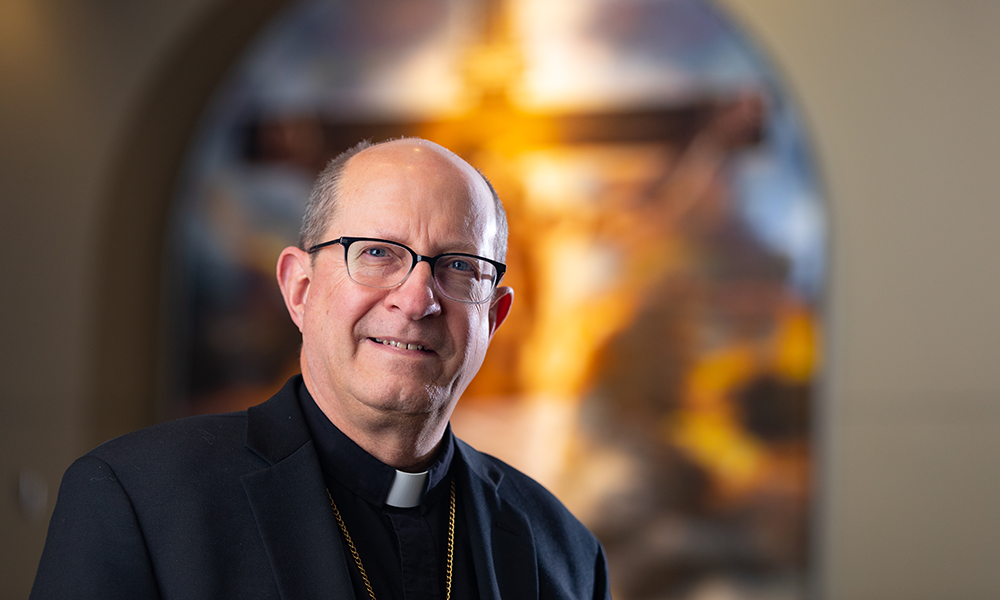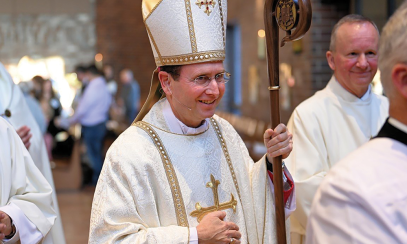
Bishop Walkowiak on the teaching tool Jesus used most
How to Evangelize Through Diocesan Communications
How to Evangelize Through Diocesan Communications
STORIES GIVE US THE CAPACITY TO UNDERSTAND THINGS IN A NEW AND EXCITING WAY.
Most of us have memories of our parents reading us a bedtime story or our grandparents regaling us with tales of days gone by. And while there are many ways to evangelize in today’s day and age, we still come back to what Christ knew and understood – the power of a story.
As he prepared to celebrate the 10th anniversary of his episcopal ordination on June 18, 2023, Bishop David Walkowiak reflected on the role of diocesan communications in advancing the kingdom through storytelling.
In your view, what is the role of a diocese – and specifically, diocesan communicators – in the work of evangelization?
The role of a diocese is to advance the kingdom of God, which is basically inviting others to come to know the great love God has for them. The only way you can accomplish this is through communication. In the 21st century, there are many ways to proclaim the Word and all that God has revealed through Jesus. And so, diocesan communications in their various forms are quite essential in evangelization efforts.
How can diocesan communications support ministries and parishes to spread the Good News of Jesus Christ?
Diocesan communications can support ministries and parishes through the content they publish. Unless we can bring to light the good things that are being done in our communities of faith, nobody will know about them. For example, our FAITH Grand Rapids magazine highlights stories of interest, things that are going on in our parishes and people who are making a difference by leading vital, productive lives for Christ. All of this forms a way of communicating the truth of what God has revealed through the Bible and 2,000 years of the Church’s life.
"We still come back to what Christ knew and understood – the power of a story.”
Let’s talk about the power of parables. Jesus taught through stories, the magazine shares faith stories. Why are stories so powerful?
One of the reasons parables are powerful is that they are paradoxical, in other words, the answer that we are expecting is not the answer that emerges from the parable. We are reminded time and time again in reflecting on the parables and in hearing them proclaimed that God’s ways are not our ways. Why for example, should someone who works one hour be paid the same wage as someone who works 12 hours? God reveals his teachings to us through parables in ways that we would not otherwise understand. We can reflect on these stories for an entire lifetime. Yet, each time we hear the Good Samaritan, the Prodigal Son, the Sower and the Seed, etc., we learn more about who God is and what God’s love is like.
The same thing is true in today’s Catholic living. There are stories that can, against all expectations, show how people have done unexpected, challenging, risky things. And because they put their trust in God, it has borne great fruit. This can be an encouragement for us, and it helps to have some current examples of people who have handed over their lives to the Lord, placed their trust in the Lord, and as a result, great things have happened.
“People respond when they see what others are doing and realize they may be capable of the same kinds of good things.”
FAITH Grand Rapids celebrated its 15th year in 2022. Why is your diocesan magazine so important to the evangelizing mission of the diocese?
We are blessed to be celebrating our 15th year of publication. The question many leaders are asking is: How do we reach our Catholic people, especially if they are not attending Mass? One of the best ways is through FAITH magazine – it’s colorful, it’s attractive and people are drawn to open it up and see what is in there. People love stories about people and interesting projects. These things can encourage them to look at their own lives and the talents and abilities that God has given them to ask, “What is God’s project for me?” “How has God equipped me with grace and talent and ability to serve the Lord?” And I think that’s very important. The magazine is a way in which a person’s faith can come alive. People respond when they see what others are doing and realize they may be capable of the same kinds of good things.
Hispanic ministry is a pastoral priority of yours. How does the Spanish-language version of FAITH Grand Rapids play into this ministerial priority?
Hispanic ministry is a pastoral priority in this local Church. The Spanish-language issues of the magazine reinforce that. Our Latino brothers and sisters are very, very important to our Church. They are the Church and a growing part of the Church here, so we want to make sure that they, too, are included in the communications about how God is working in West Michigan through people of faith and families of faith, our parishes.
To reach out, we publish a flip edition of FAITH Grand Rapids magazine in the Spanish language every quarter. The content of those editions is geared toward the life that our Latino brothers and sisters are living. It’s not simply a translation of the English version of the magazine. The Church is diverse, and the various groupings within the Church have diverse needs and diverse talents, blessings and abilities to share. We acknowledge that; we rejoice in that; and we want to encourage continued growth in faith and missionary outreach amongst the various peoples of our diocese.
We would be doing them a great disservice, and we would not be living up to our vocation if we do not do all that we can to bring into people’s consciousness the great love that God has for them and the response that God expects from us.”
FAITH Grand Rapids is sent to every registered Catholic household in the diocese. Why is it important to ensure that this publication is sent into peoples’ homes? What message do you send by making it available even to people who don’t regularly attend Mass?
The importance of sending FAITH Grand Rapids to all of the people that parishes know of is that we get the Good News into the place people spend perhaps most of their lives, at home. We have websites and social media, but we find that people tend to go to their favorite websites and don’t search the web for Catholic content, or even local Catholic content. So, while a magazine format seems to be somewhat dated in terms of its state-of-the-art status, it is effective.
It’s kind of like radio. Radio has been around since the 1920s. People still listen to the radio in their cars, while they’re working around the home or while they’re working outside. It’s been around for more than 100 years, but people still find it of value. The same thing can be said for an attractive format like FAITH magazine. People will open it up. You look at the people on the cover, and you want to find out what their story is. You are edified by the way they are living their lives and the things that God has been able to do through them. How else are we going to show Catholics that having a relationship with God and cooperating with him in whatever God has in mind for us is exciting? It is an adventure that leads to a sense of joy and a sense of meaning in one’s life.
As we know, a great majority of Catholics don’t come to Sunday Mass, so this is a way in which we can maybe strike a spark to get them to realize how much richer and fuller life can be by knowing, loving and serving God and coming together with people who believe the same.
People will open it up. You look at the people on the cover, and you want to find out what their story is. … How else are we going to show Catholics that having a relationship with God and cooperating with him in whatever God has in mind for us is exciting?”
Speaking of Mass attendance, what role can Catholic communicators play in reigniting Catholics in the practice of the faith — specifically in attending weekly Mass and receiving the Eucharist?
Catholics need encouragement. We need opportunities to be reminded of what our responsibilities are as members of the human family. The first three commandments of the 10 Commandments deal with our relationship with God. The very first states, “I am the Lord thy God: thou shalt not have strange gods before me.” This means we must have our priorities straight. It means that God is the guide for our life, and while other things that are attractive and enjoyable are good in themselves, they should never get in the way between us and God. We are made for God. We are meant to be with God.
The other thing that is very important in terms of weekly attendance at Mass is that it puts us in contact with God’s Word and a homily reflecting on it, as well as providing us with the ability to be united to one another – to profess our faith and come forward to receive the body and blood of Christ. Jesus says in the Gospel of John, “… Unless you eat the flesh of the Son of Man and drink his blood, you do not have life within you.” (6:53) And later on, he says, “I am the vine, you are the branches. Whoever remains in me and I in him will bear much fruit, because without me you can do nothing.” (15:5) And so, Catholic communication through various means can remind us what we are created for, why we were created and what we must do to respond to God’s love in an appropriate way. This means that we live for him, and we strive to bring others to the great joy that comes from living for the Lord.
We simply cannot sit on our hands because people need to encounter Catholic content. If we don’t reach out and push it into their homes or onto social media, then it won’t even cross their minds. We would be doing them a great disservice, and we would not be living up to our vocation if we do not do all that we can to bring into people’s consciousness the great love that God has for them and the response that God expects from us.
Bishop David J. Walkowiak, Bishop of the Diocese of Grand Rapids
Photo by Rob Schumaker



